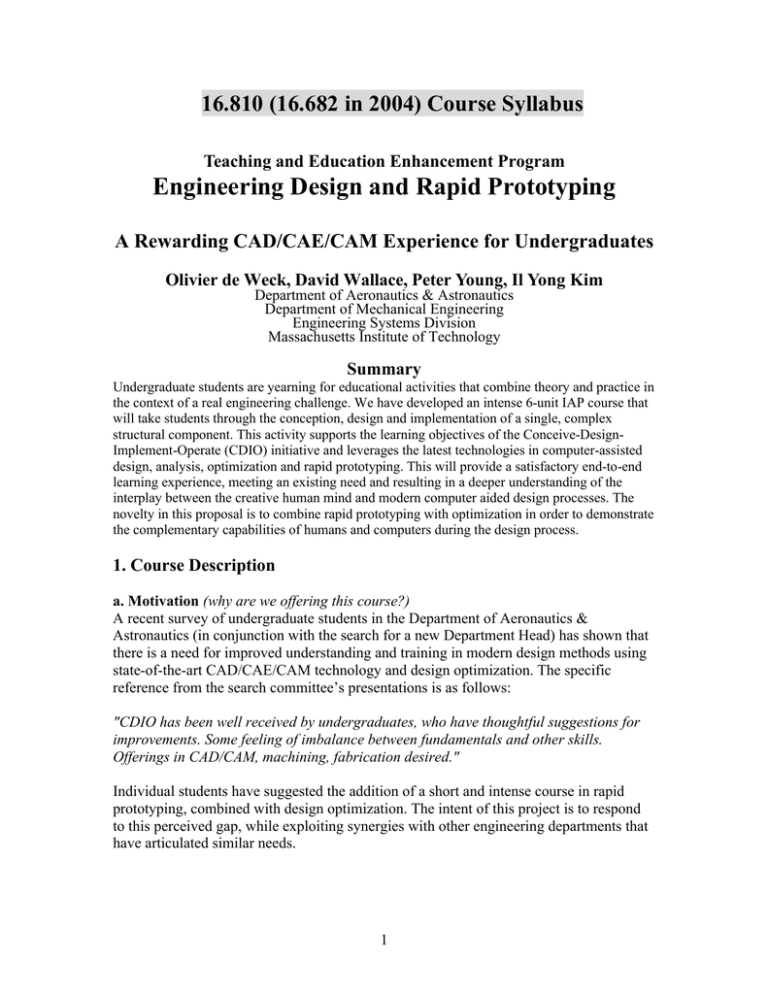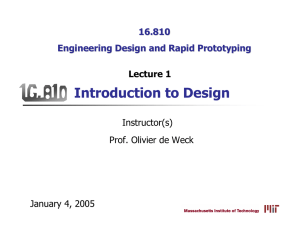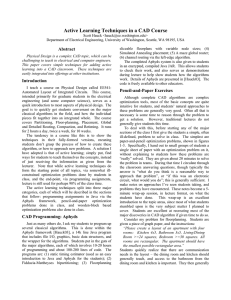Engineering Design and Rapid Prototyping 16.810 (16.682 in 2004) Course Syllabus
advertisement

16.810 (16.682 in 2004) Course Syllabus Teaching and Education Enhancement Program Engineering Design and Rapid Prototyping A Rewarding CAD/CAE/CAM Experience for Undergraduates Olivier de Weck, David Wallace, Peter Young, Il Yong Kim Department of Aeronautics & Astronautics Department of Mechanical Engineering Engineering Systems Division Massachusetts Institute of Technology Summary Undergraduate students are yearning for educational activities that combine theory and practice in the context of a real engineering challenge. We have developed an intense 6-unit IAP course that will take students through the conception, design and implementation of a single, complex structural component. This activity supports the learning objectives of the Conceive-DesignImplement-Operate (CDIO) initiative and leverages the latest technologies in computer-assisted design, analysis, optimization and rapid prototyping. This will provide a satisfactory end-to-end learning experience, meeting an existing need and resulting in a deeper understanding of the interplay between the creative human mind and modern computer aided design processes. The novelty in this proposal is to combine rapid prototyping with optimization in order to demonstrate the complementary capabilities of humans and computers during the design process. 1. Course Description a. Motivation (why are we offering this course?) A recent survey of undergraduate students in the Department of Aeronautics & Astronautics (in conjunction with the search for a new Department Head) has shown that there is a need for improved understanding and training in modern design methods using state-of-the-art CAD/CAE/CAM technology and design optimization. The specific reference from the search committee’s presentations is as follows: "CDIO has been well received by undergraduates, who have thoughtful suggestions for improvements. Some feeling of imbalance between fundamentals and other skills. Offerings in CAD/CAM, machining, fabrication desired." Individual students have suggested the addition of a short and intense course in rapid prototyping, combined with design optimization. The intent of this project is to respond to this perceived gap, while exploiting synergies with other engineering departments that have articulated similar needs. 1 b. Educational Objectives (what are we trying to accomplish?) The overall learning objective of this activity is for students to develop a holistic view of and initial competency in engineering design by applying a combination of human creativity and modern computational methods and tools to the synthesis of a complex structural component. This goal can be mapped into the following learning objectives of the CDIO syllabus [1]: 1.2.2 Core Engineering Fundamental Knowledge: Solid Mechanics & Materials 1.3.6 Advanced Engineering Fundamental Knowledge: Computational Techniques 2.1.2 Engineering Reasoning and Problem Solving: Modeling 2.4.3 Personal Skills and Attitudes: Creative Thinking 4.3.3 Conceiving and Engineering Systems: Modeling of System and Ensuring Goals can be met 4.4.1 The Design Process: Execute appropriate optimization in the presence of constraints 4.5.2 Implementing: Hardware Manufacturing Process1 4.5.5 Implementing: Test, Verification, Validation and Certification c. Pedagogy (how do we plan on achieving the objectives?) The goal of the class is to provide the students with an opportunity to conceive, design and implement products quickly as a single component, using the latest rapid prototyping methods and CAD/CAE/CAM technology. This is meant to be an intense and satisfying experience, emphasizing the chain of design steps as shown in Figure 1. Fig.1: 16.810 Course Pedagogy 1 Using mainly the CNC water jet cutter available in the Dept. of Aeronautics & Astronautics 2 The idea of decomposing the course into two phases is rooted in the following cognitive progression. In the first phase the students are presented with solution neutral requirements and constraints for a structural component. A creative process of hand sketching is followed by computer assisted design (CAD) and analysis (CAE). This will help the students ascertain that their initial design will theoretically meet the requirements. After some manual iteration the part specification will be implemented on water jet cutting equipment2. The prototype is subjected to some simple testing in the lab to verify the validity of the student predictions. (The first offering of the course will focus on a 2D component to reduce part complexity). The second phase takes the initial manual design as an input and improves the solution via design optimization. The students will conduct design optimization using either commercial or faculty-provided software. The optimum solution obtained is modeled as a CAD model, and again the CNC equipment is used to fabricate the improved component. The optimized component is compared with the hand-designed one and conclusions are drawn. The course will conclude as a small “competition” with actual load-to-failure testing of the initial and optimized designs. This side by side comparison helps produce several educational insights: - understand predictive accuracy of CAE modeling versus actual test results understand relative improvement that computer optimization can yield relative to an initial, manual solution illustrate the capabilities and limitations of the human mind and digital computer We will give a limited set of lectures on fundamental design theory and design optimization in parallel to the design development of the real artifact (hands-on activities) as described in the above schedule (page 2). d. Detailed Plan See schedule on page 2. This plan starts by exposing the students to the design process, its phases and the importance of properly formulated requirements. An introduction to state-of-the-art CAD/CAE/CAM environments will be given during the first week. Initial hands-on activities include hand sketching, engineering drawings and CAD Modeling. Due to the time limitations of this IAP course, compromises have to be made in terms of the breadth and depth of some of the topics that are covered. Emphasis is on successfully completing the various steps of the design process, rather than understanding all the details of the methods and tools used along the way. Two assumptions will deliberately limit the 2 The exact part requirements and tasks for each team will be assigned during the first lecture. 3 complexity of this undertaking in order to not overwhelm the students and ensure focus on the learning objectives outlined in Section 1.b): Part Complexity: The project will be limited to a single structural component with medium complexity (some boundary conditions, one single load case, some functional surfaces and forbidden zones). The maximum part dimensions are governed by the limitations of the CNC machining equipment in Bldg. 33, but will be approximately 12” x 12” x 0.5”. No assemblies, machines or mechanisms will be produced. The part complexity might be modified in future years as we learn more about feasibility, student ability and time constraints. Dimensions: We will limit the design task to 2 dimensions. This will significantly simplify hand sketching and CAD modeling. The parts might still have to fulfill 3D requirements (e.g. out-of-plane bending of flexures), even if they are designed in 2D. A flowchart of the class activities, including student deliverables is shown in Figure 2. Learning/Review Problem statement Deliverables Hand sketching Design v1 CAD/CAM/CAE Intro CAD design FEM/Solid Mechanics Overview FEM analysis Analysis output v1 Manufacturing Training Produce Part 1 Product v1 Structural Test Training Test Experiment output v1 Design Optimization Optimization Design/Analysis output v2 Produce Part 2 Product v2 Test Experiment output v2 Design Competition Fig. 2: Flowchart of Engineering Design and Rapid Prototyping class 4 2. Target Student Population The initial offering of the class will be limited to 16 students, broken down into 8 teams of two students each. Because the class is laboratory oriented, it is preferable not to have too many students. Also, the number of seats in the Design Studio, 33-218, and the capacity of the machine shop are inherently limited. The appropriate level would be seniors and juniors who have basic knowledge of mechanics, engineering mathematics and design. We would also admit sophomores with previous experience if there is extra capacity. Enrollment will be limited. The course is targeted primarily for undergraduate students in the MIT School of Engineering with emphasis on Aeronautics & Astronautics and Mechanical Engineering. 3. Impacts of the Course This course will enable the students to: (1) Experience the conceive-design-implement-operate process for a single, complex component using the latest CAD/CAE/CAM technology. (2) Understand the subtleties of complementary human design abilities and computer strengths in optimization and number crunching. Quantify the relative improvement that computer optimization can yield relative to an initial, manual solution. (3) Understand the predictive accuracy of CAE modeling versus actual laboratory test results. (4) Obtain 6 units of credit during IAP (with letter grade) in order to fulfill non-GIR requirements (electives) and meet their required credit limits for graduation. Many students are looking for opportunities to obtain such credits, without imposing additional scheduling constraints during the regular semesters. This course will enable the department to: (1) Further implement the vision of CDIO. This is done without imposing additional burden on the students or the teaching infrastructure during the regular semesters. (2) Offer an introductory course in Design (16.810), offered by the Systems Division, which is complementary to the current IAP offering of 16.900 in Computational tools. (3) Improve our CAD/CAE/CAM infrastructure. Even though we have purchased expensive equipment and software during the last 5 years, it must be said that the CAD/CAE/CAM chain has not been fully integrated in the 5 department. This course offers an opportunity to do so at low expense. This also has the potential to benefit other projects. (4) Increase the effectiveness of students in downstream capstone courses. Both the experimental courses 16.621/2 as well as the aerospace vehicle design Capstone sequences 16.684-6 require an understanding of design and manufacture of components. In the first class components are used to build an experimental test apparatus. In the second class the components are assembled and integrated into a prototype aerospace vehicle (e.g. SPHERES, ARGOS…). Students that will have taken 16.810 are therefore likely to be more effective in designing and building components and would benefit more from 16.62x and 16.68x. 4. Resources a. Faculty and Staff Prof. Olivier de Weck Robert N. Noyce Assistant Professor of Aeronautics and Astronautics and Engineering Systems. Prof. de Weck has taught concept selection and conceptual design optimization in a class on System Architecture (16.882/ESD.34J) at MIT and created a new Multidisciplinary System Design Optimization class (16.888/ESD.77) for graduate level students. His research interests are in System Architecture and Multidisciplinary Design Optimization. Before coming to MIT he worked in a CAD/CAE/CAM intensive environment at McDonnell Douglas (now Boeing) on the F/A-18 aircraft program from 1991-1996. Dr. Il Yong Kim Postdoctoral Associate in the MIT Department of Aeronautics and Astronautics. Dr. Kim’s expertise is in design optimization, and he has developed a computational tool that performs design optimization for structural topology optimization and structural plate optimization problems. He has taught CAD and advanced mathematics. He is a 2001 graduate of Korea Advanced Institute for Science and Technology (KAIST). Prof. Dave Wallace Associate Professor of Mechanical Engineering and Engineering Systems. Prof. Wallace is a tenured, associate professor in the department of mechanical engineering. His research field is integrated computer aided design and industrial design and aesthetics. He is teaching product design and industrial design in the department. He is the director or the MIT CADlab. Peter Young, Col, USAF (ret.) Senior Lecturer in Aeronautics and Astronautics. Colonel Young is a senior lecturer in the department of Aero/Astro specializing in developing and implementing ‘hands on’ undergraduate engineering projects. He has 29 years service on US Air Force space and missile programs. He is the director of CDIO initiatives in the Department of Aeronautics and Astronautics. 6 b. Facilities * Software and Manufacturing Equipment - General computing: MATLAB - CAE: COSMOS - CAD: SOLIDWORKS - CAM: OMAX - Manufacturing equipment: CNC digital water cutter (Gelb Laboratory). * MIT Facilities - Design Studio This concurrent engineering facility is comprised of 14 networked CAD/CAE workstations that are used for complex systems design and optimization. It is our intent to carry out part of the research in this facility. This is also an excellent setting for conducting conceptual design exercises for the class. - Gelb Laboratory and Machine Shop - CAD-Room Fig. 3 Artist’s rendition of the Design Studio (Complex Systems Development and Operations Laboratory) 7 5. Evaluation and assessment of the class The class is unique in that it integrates design theory, computational skills and fabrication/validation. It will enhance students’ understanding of engineering design theory and practical design skills. The course is 3-3-0, meaning that there will be two 90 minute lectures per week and about three hours of lab work expected (either in the Design Studio, machine shop or structural testing lab). There is no explicit homework, except for the team deliverables shown in Fig.2. Grading (A-F letter grade) would be based on the following components: Design Deliverables (see Figure 2) - Hand Sketch, Design, CAD Model, FEM analysis Hardware Parts - Part Requirements Compliance Active Class Participation Total 50% 30% 20% ___________ 100% An end-of-class survey will be conducted. 6. References [1] CDIO Syllabus Report, MIT, 2001 [2] Atlla Ertas and Jessec Jones, The engineering design process, Willey, 1993 [3] Kunwoo Lee, Principles of CAD/CAM/CAE systems, Addison Wesley, 1999 [4] Erik Antonsson and Jonathan Cagan (ed), Formal Engineering Design Synthesis, Cambridge, 2001 Acknowledgments: This course is made possible thanks to a grant by the alumni sponsored Teaching and Education Enhancement Program (Class of ’51 Fund for Excellence in Education, Class of ’55 Fund for Excellence in Teaching, Class of ’72 Fund for Educational Innovation). We gratefully acknowledge the financial support. The course was approved by the Undergraduate Committee of the MIT Department of Aeronautics and Astronautics on September 19, 2003. We thank Prof. Manuel MartinezSanchez and the committee members for their support and suggestions. 8







